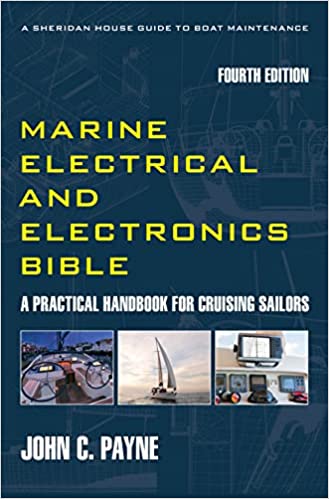Boat Hit by Lightning
When your boat hit by lightning is often seen as a surprise. Generally you don't get a lightning bolt out of the blue, although it does happen. You can improve your lightning safety by doing some basics and preparing. Always keep a weather eye, as conditions can change quickly. Depending on the type of boating you do, it is many cases safer to head home rather than tough out a passing squall or thunderstorm. Lightning is not always predictable and certainly what it will strike is not. Always choose to stay safe when out on the water.
Is lightning Alternating Current (AC) or Direct Current (DC)? The answer is neither and it is essentially a combination of both and is termed a transient electrical pulse, transient impulse or impulse signal. The AC component is that given it is a high frequency discharge, it can be unpacked into frequency components and radiates electromagnetic energy. This is explained in the Marine Electrical and Electronics Bible, 4th Edition.
The 4th Edition of the Marine Electrical Electronics Bible Get your copy and start becoming self sufficient and save money on expensive technician callouts.Boat Hit by Lightning
Personal Safety
In an electrical storm, the following precautions should be taken to avoid any shock or something more serious:
1. Stay below decks at all times.
2. Stay well away from mast, boom shrouds, chain plates and the mast compression post or mast if below deck.
3. Take a position and plot it prior to shutting down, or in case of all electronics equipment being blown.
4. Turn off all electronic gear and isolate circuit breakers if at all practicable. Disconnect aerials also if practicable.
5. Do not operate radios until after the storm unless in an extreme emergency.
6. After a lightning strike, be aware that the compass may be incorrect.
7. Check all running rigging and fittings after a lightning strike as damage can occur that may seriously affect vessel capacity to sail. Protect yourself against a lightning bolt!
8. Check all through hull fittings for damage, if you have decided to risk bonding them. Usually if they are damaged or gone, you will see water over the cabin sole.
It is hoped that this offers some way through the ranges of conflicting information, and it is better to at least implement some of the basic recommendations than do nothing.
As summer comes to an end there will be the usual reports of lightning-bolt, strikes and damages, many will criticize various rules and recommendations, and in many cases the measures used will be either partial or badly installed to some degree.
One should not be deterred or put off by these reports. Hopefully readers had an enjoyable and not too traumatic time.
The National Weather Service (NWS) provides a continuously and updated weather forecast for Florida and adjacent coastline on VHF/FM channels WX1 (162.550 MHz), WX2 (162.400 MHz), WX3 (162.475 MHz)
The 4th Edition of the Marine Electrical Electronics Bible Get your copy and start becoming self sufficient and save money on expensive technician callouts.Boat Hit by Lightning
Monitor the Weather
If you think your boat has been struck by lightning or had a very close lightning strike near your boat, you do
need to perform some inspections and assessments:
a. Through Hulls. Check all through hull fittings for damage, if you have bonded bronze thru hull valves in an overall system. Usually if they are damaged or blown out you will probably see water rising over the cabin sole. Start the bilge pumps! I carry wooden plugs for such eventualities.
b. Communications. Check your VHF and other radios, and verify they are operational. A masthead strike often takes out the masthead radio aerial, along with masthead instruments.
c. Marine Electronics. Check all your electronics equipment, such as GPS, AIS and radar and confirm operation. Mast mounted radar scanners usually get destroyed in strike events.
d. Engine. Operate your engine, many new generation engine control panels are electronic, as are some engines with an Electronic Control Unit (ECU).
e. Battery Charging. Operate the engine and verify the alternator is charging the battery as diodes can be destroyed.
f. Compass. Check your compasses as in some cases, complete demagnetization may occur.
g. Rigging. Check all running rigging and fittings, as they may be damaged and seriously affect the vessel capacity to sail. This also includes mast and headsail furlers and so on, especially electrically operated ones. Sheaves are often plastic, acetal or aluminum. When strike currents circulate at the masthead, they do so through sheave pins and axles and if enough heat or arcing occurs, the sheaves start seizing up.
What is St. Elmo's Fire?
What is St. Elmo's Fire? Also known as Brush Discharge. When this strange phenomenon occurs, it usually precedes a lightning strike, although the effect does not occur all the time. The vessel becomes a large ground mass. The discharge is characterized by ionized clouds and balls of white or green flashing light that polarize at the vessel extremities. The discharge of negative ions reduces the potential intensity of a strike.
Saint Elmo’s Fire is a glowing blue or violet light seen on vessels masts during storms, historically viewed by sailors as a sign of divine protection.
This phenomenon occurs when atmospheric electricity ionizes the air around pointed objects like masts, creating a visible corona discharge. Named after St. Erasmus (St. Elmo), the patron saint of sailors, it was often interpreted as reassurance during turbulent seas. Sailors believed the light meant they were being watched over, continuing their voyages with renewed courage. Though once considered mystical, it’s now understood as a natural plasma effect linked to thunderstorms and high-voltage conditions.
Do you want more lightning protection and related boat electrical systems if boat hit by lightning. This article was extracted from The Marine Electrical & Electronics Bible and this is available through Amazon.com. Protect yourself against a lightning strike!
